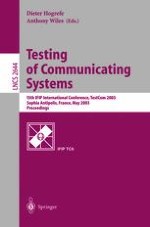2003 | Buch
Testing of Communicating Systems
15th IFIP International Conference, TestCom 2003, Sophia Antipolis, France, May 26–28, 2003 Proceedings
herausgegeben von: Dieter Hogrefe, Anthony Wiles
Verlag: Springer Berlin Heidelberg
Buchreihe : Lecture Notes in Computer Science
Enthalten in: Professional Book Archive
